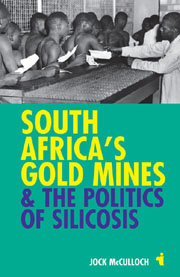Book contents
- Frontmatter
- Contents
- List of Photographs
- Preface: South Africa in the Twentieth Century
- Acknowledgments
- List of Abbreviations
- A Brief Chronology
- 1 Gold Mining & Life-Threatening Disease
- 2 Creating a Medical System
- 3 Compensation
- 4 A White Science
- 5 Myth Making & the 1930 Silicosis Conference
- 6 Tuberculosis & Tropical Labour
- 7 Conflict over the Compensation System
- 8 Healing Miners
- 9 The Sick Shall Work
- 10 Men Without Qualities
- Select Bibliography
- Index
5 - Myth Making & the 1930 Silicosis Conference
Published online by Cambridge University Press: 05 February 2013
- Frontmatter
- Contents
- List of Photographs
- Preface: South Africa in the Twentieth Century
- Acknowledgments
- List of Abbreviations
- A Brief Chronology
- 1 Gold Mining & Life-Threatening Disease
- 2 Creating a Medical System
- 3 Compensation
- 4 A White Science
- 5 Myth Making & the 1930 Silicosis Conference
- 6 Tuberculosis & Tropical Labour
- 7 Conflict over the Compensation System
- 8 Healing Miners
- 9 The Sick Shall Work
- 10 Men Without Qualities
- Select Bibliography
- Index
Summary
The 1930 Silicosis Conference in Johannesburg was a pivotal moment in the global response to occupational disease. Sponsored by the ILO and the Transvaal Chamber of Mines, it brought together delegates from Canada, the UK, the USA, Australia, Italy, the Netherlands and Germany. Given the slowness of travel in 1930, it was probably the first time that many of those scientists had met. The siting of the Conference was recognition of the achievements of South Africa in terms of research, data collection and state regulation. The data included the world's largest collection of X-rays of a workforce. As the British expert Arthur J. Hall observed: ‘The statistics of South Africa were so unique and of such importance too all countries which had to initiate legislation and compensation that every effort should be made to make them as clear as possible.’ The political context was complex. A tide of litigation was engulfing US foundries, hard rock mines and cement manufacturers, there was an asbestos crisis in the UK, a commission of inquiry into miners' phthisis had been held in South Africa the previous year and an international congress on occupational diseases was scheduled in Lyon.
The impetus for the Conference came from Dr Luigi Carozzi of the ILO, William Gemmill, the General Manager of the Transvaal Chamber of Mines, and the Chief Medical Officer for the Rand Mines Group, A. J. Orenstein.
- Type
- Chapter
- Information
- South Africa's Gold Mines and the Politics of Silicosis , pp. 74 - 84Publisher: Boydell & BrewerPrint publication year: 2012



